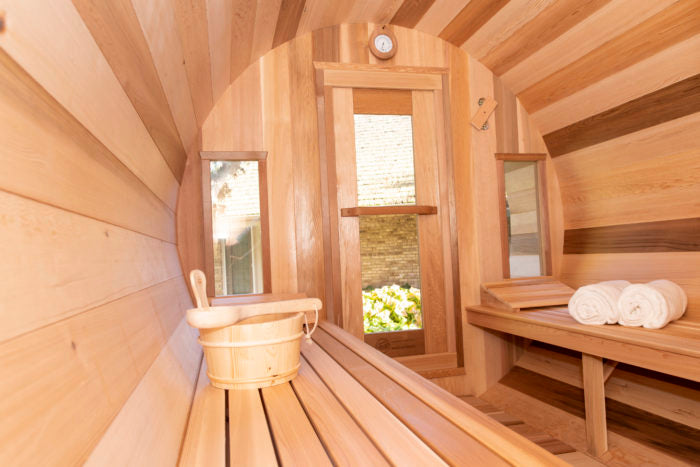The Definitive Guide for Traditional Sauna
The Definitive Guide for Traditional Sauna
Blog Article
The Ultimate Guide To Traditional Sauna
Table of ContentsTraditional Sauna for BeginnersFacts About Traditional Sauna UncoveredWhat Does Traditional Sauna Do?Traditional Sauna for Dummies
The majority of the weight shed in a sauna is water loss and is re-gained upon rehydrating. Nevertheless, certainly sauna can be a vital part of a healthy and balanced weight-loss program. To consider the differences in between conventional and IR saunas, I will separate these right into verifiable, theoretical, and fabricated differences.Therefore, the best factor in the saunawhich goes to the ceiling directly over the sauna heateris normally in between 185 and 190 F. Traditional Sauna. Claims that a typical sauna surpasses 200 F is just not real and not relevant for electric saunas offered in the US. The temperature for a far-infrared sauna is normally set between 120 and 140 F; however, unlike the traditional sauna, the goal in and IR space is not to accomplish a high temperature
Because of this, the temperature level difference is practically unnecessary, considering that excessive sweating results in both sauna types, but the approach of warming the body is various. In an IR sauna the bather will really feel warm and will sweat a lot, but at a lot reduced temperatures. Thus, if the goal is to spend longer periods of time in the sauna, the IR sauna is a good choice.

Some Known Details About Traditional Sauna
When the high temperature is achieved, the elements cycle on and off to maintain the heat. A lot of standard sauna users enjoy putting water over the rocks to create steam to elevate sauna humidity degrees. The advantages of putting water over the rocks consist of: making the room much more comfy, dampening the nasal passages, and allowing the usage of aromatherapy by mixing crucial oils with the water.
In a far-infrared sauna, the warm waves permeate the body to properly warm the body and increase the body core temperature. To achieve this enhanced temperature, Far-infrared emitters develop infrared power which is close to the very same wavelength as that which the body normally emitsoften described as the "Important Range" of 7 to 14 microns), so the energy is well obtained by the body.
When the power goes into the body, it creates the body temperature level to increase and eventually leads to sweating. In an infrared sauna it is necessary for the emitters/heaters to remain on almost regularly. Since there is no mass of rocks to retain warm, the sauna will certainly cool have a peek at this site down if the emitters shut down.
As mentioned above, the sauna bather in an infrared room intends to place himself before running emitters to get maximum advantage from the warm. The heating time for both rooms can be very different, depending upon how the spaces are utilized. For a conventional sauna, a bather needs to enable 30-40 minutes for the space to attain a wanted temperature level and to properly pre-heat the rocks.
Not known Factual Statements About Traditional Sauna
A well created sauna will commonly attain a temperature of 150-160 F in concerning 30-40 mins. For hotter temperatures, the space might require to heat for a longer duration.
To some, 15 minutes was "lost" while the infrared energy heated the wood panels instead of heating a body, while others discover a pre-heated room to be a lot more comfortable and believe an elevated starting temperature is essential to begin sweating. The length of recommended use for each and every area is roughly the exact same (10-15 minutes per session); however, as a result of the reduced air temperature levels and the ability to feel the effects of infrared heat faster than a conventional sauna, it is not uncommon for an individual to invest a total of 20-30 mins in an infrared sauna.
Typical saunas often tend to be bigger (for this reason utilize even more power) than infrared saunas, although conventional saunas are definitely offered in one and 2 individual dimensions. For a two-person typical sauna, 5x6 or 5x7 size is most popular. The top bench can comfortably seat two or three individuals and is also long enough to lie down throughout the sauna session.


The ordinary expense per kWH of electricity in the U.S. is roughly $0.11, click to read so a 4.5 kW heating unit will cost about $.50 to run for one hour, if the heating unit runs continually for one hour. Normally a sauna heater will compete 75% of the very first hour and 50% of subsequent hours on given that the aspects cycle once the established temperature level is achieved.
8 Simple Techniques For Traditional Sauna
A two individual far-infrared area is usually literally smaller sized than a standard sauna, often regarding 4' x 4' or smaller. The IR heating system is typically 1.5-1.7 kW using a 120 volt 15 amp plug-in click this link service. Considering that the space can be used quicker than a sauna area, we will certainly assume the area is used for to of an hour consisting of warm up time.
There is a hardly ever talked about difference in the social experience in between the 2 areas. While our culture has actually shed some of the social advantage of the standard sauna experience, it can be extremely socially rewarding. From family time in the sauna, to heart-felt conversations with considerable others, to sauna partiesthe traditional sauna experience can bring about intimate mingling.
A lot of higher end infrared areas consist of colored light treatment, noise systems and full-glass fronts.
Report this page